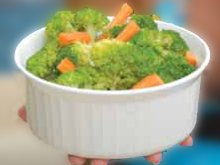Health Topics
-
Healthy Living
-
|
|
May 2011
|
| Diet During Travel |
| Dr. Panchali Moitra |
| |
 |
Summers, holidays and trips...they all seem to come together in a package. Whether you are planning a trip for leisure or business, sticking to a nutritional diet regime during travelling becomes a daunting task. The restricted eating out choices, lavish social celebrations and most importantly, our carefree holiday mood seem to team together to derail all our dieting efforts. |
Tips to Prevent Holiday Diet Disasters
- The key to holiday eating is planning. Plan ahead and always keep healthy snacks handy. Bring a packet of wheat khakras, bran biscuits, roasted chana, peanuts, other nuts (almonds, cashews) and fresh fruit with you.
- Cut calories wherever you can. Avoid thick sauces, mayonnaise, cream soups, rich salad dressings, refined flour products. Just ordering a sandwich without mayonnaise, for example, can save you 30 grams of fat.
- Make sure you're eating high-fibre foods, which are plant foods, like fruit and vegetables, beans and grains.
- Drinking plenty of bottled water will also help fill you up and keep you from feeling fatigued.
- Identify your weak foods (usually pizzas and pastries)and try to avoid them. And ifyou just broke down and had a pizza or a chocolate pastry, forget it and do something positive (i.e. eat more veggies in the next meal, go for a walk, do some more push ups).
- Do some light exercise in your room:push-ups, sit-ups, and spot marching don't require you to put on gym clothes and make the big trip to the gym. You can do a mini workout of 5-15 minutes in your room when you wake up or in the evenings.
- There exist a myriad of healthy snacks and meal options available at food joints and they are just as affordable and delicious as the higher fat and less nutritious versions.With little effort and will power,one can enjoy the varied local cuisines without blowing away the diet.
| A 7 day nutritional menu(which is fun too!) |
|
DAY
|
BREAKFAST
|
MEALS
|
DESSERT
|
| 1 |
milk and cereal |
bread and vegetables |
fresh fruit |
| 2 |
whole wheat bread sandwich and orange juice |
grilled chicken/Fish+ soup+ salads |
fruit yoghurt
|
|
3
|
idli sambhar or dhokla
|
chappati + vegetables + yoghurt |
dates |
|
4
|
toast and egg whites with a banana |
rice, lentils and vegetables |
black grape salad with yoghurt dressing |
|
5
|
poha/upma |
wheat pasta with greens and clear soup |
rasgulla or low fat ice creams |
| 6 |
vegetable kathi rolls without cheese |
bean salad and breads |
pineapple slices with low sugar cream |
| 7 |
soya milk and oats |
smoked chicken or paneer sandwiches |
fruit custard |
Eating Guidelinnes on a Trip
- When ordering main entrees, look for items that are steamed, braised, roasted, simmered, or stir fried.
- Choose steamed dumplings (veg or non-veg) with plain rice over fried ones. When eating Chinese or Oriental cuisine, some good choices would be lemon chicken in ginger sauce with steamed rice or Oriental chicken salad (garden vegetables and mixed greens tossed with light garlic vinaigrette, served without wonton strips) along with plain rice noodles. You can even go one step further in the direction of health and ask for brown rice (rich in complex carbohydrates) based recipes.
- Among soups, go for clear chicken or vegetable soup such as Tom yum or Talumien soup or even coriander soup. They are low in calorie content, devoid of cornstarch, provide satiety and offer a great way to start any meal.
- Most Chinese cuisine is very high in sodium, with the use of monosodium glutamate and soy sauce, so opt for dishes prepared without them. Go for the dishes prepared with hot mustard, sesame seed paste or plum sauce.
- Try to avoid sauces or ask for all sauces (including salad dressing, mayonnaise and butter) on the side so that it becomes easier to control the amount you use.
- Go for the smaller portion size if you have a choice. It’s the easiest way to reduce the temptation to overeat.
- Ask for rice, wheat pasta or whole wheat chapattis instead of white breads and refined flour noodles.
- Roomali roti, naans or paranthas are best avoided as they are laden with saturated fats and are made up of maida or refined flour, which are deficient in fibre, high on glycemic index and a complete no-no for weight watchers.
Make the right choices, ask for what you need, and balance your meals out with healthy meals at home. Happy Holidays! |
 |
Dr.Panchali Moitra is a Nutrition Expert, Weight Management Consultant and Specialist in Alternative Medicine |
|
|